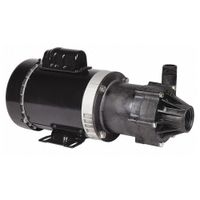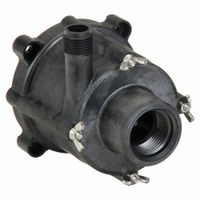Call +(254) 703 030 000 / 751 483 999 / 721 704 777
- Home
- Pumps
- Straight Self Priming Submersible Centrifugal Pumps
- Straight Centrifugal Pumps Motors Impellers Seals
- Magnetic Drive Straight Centrifugal Pumps
Magnetic-Drive Straight Centrifugal Pumps
Magnetic drive (mag-drive) pumps utilize magnets to turn the impeller inside the housing, which transfers liquids through a system. The impeller and pumping fluid are sealed from the motor's drive shaft, making these pumps suited for handling corrosive liquids. Chemical-resistant magnetic-drive stra .....Read More
Frequently Asked Questions
What are magnetic drive pumps used for?
Magnetic drive pumps are used for transferring fluids without the need for a direct mechanical seal, which eliminates the risk of leakage. They are particularly beneficial in applications involving hazardous, toxic, or corrosive fluids, as the absence of a mechanical seal reduces the potential for environmental contamination and enhances safety. These pumps are commonly employed in chemical processing, pharmaceuticals, petrochemicals, and food and beverage industries.
In chemical processing, magnetic drive pumps handle aggressive chemicals and acids, ensuring safe and leak-free operation. In the pharmaceutical industry, they are used for transferring sensitive and high-purity fluids, maintaining product integrity. The petrochemical sector utilizes these pumps for handling hydrocarbons and other volatile substances, minimizing the risk of leaks and explosions.
Magnetic drive pumps are also used in water treatment facilities for handling chemicals like chlorine and sodium hypochlorite, ensuring safe and efficient operation. In the food and beverage industry, they are employed for transferring flavorings, colorings, and other additives, maintaining hygiene and preventing contamination.
Additionally, these pumps are used in applications requiring high-purity conditions, such as semiconductor manufacturing, where they handle ultra-pure water and chemicals without introducing contaminants. They are also suitable for handling heat transfer fluids in cooling and heating systems, as they can operate at high temperatures without the risk of seal failure.
Overall, magnetic drive pumps are chosen for their reliability, safety, and ability to handle challenging fluids without leakage, making them essential in industries where fluid integrity and environmental safety are paramount.
How do magnetic drive pumps work?
Magnetic drive pumps, or mag-drive pumps, operate using a magnetic coupling to transfer torque from the motor to the pump impeller without a direct mechanical connection. This design eliminates the need for a traditional shaft seal, reducing the risk of leaks and making them ideal for handling hazardous or corrosive fluids.
The pump consists of two main components: the outer drive assembly and the inner drive assembly. The outer drive assembly is connected to the motor and contains a set of powerful magnets. The inner drive assembly, which is attached to the pump impeller, also contains magnets. These two sets of magnets are aligned such that the magnetic field created by the outer drive assembly induces rotation in the inner drive assembly.
When the motor is powered, it rotates the outer drive assembly. The magnetic field generated by the outer magnets exerts a force on the inner magnets, causing the inner drive assembly and the impeller to rotate. This rotation of the impeller creates a centrifugal force that moves the fluid through the pump.
The absence of a direct mechanical connection between the motor and the impeller means there is no need for a shaft seal, which is a common point of failure in traditional pumps. This design minimizes maintenance requirements and enhances the pump's ability to handle aggressive chemicals, as there is no risk of leakage through a seal.
Magnetic drive pumps are widely used in industries such as chemical processing, pharmaceuticals, and water treatment, where leak prevention and chemical resistance are critical. They are particularly beneficial in applications requiring the handling of volatile, toxic, or expensive fluids.
What are the advantages of using magnetic drive pumps?
Magnetic drive pumps offer several advantages:
1. **Leak-Free Operation**: These pumps eliminate the need for mechanical seals, which are common points of failure in traditional pumps. The absence of seals reduces the risk of leaks, making them ideal for handling hazardous, toxic, or corrosive fluids.
2. **Reduced Maintenance**: With fewer moving parts and no seals to replace, magnetic drive pumps require less maintenance. This leads to lower operational costs and less downtime.
3. **Enhanced Safety**: The leak-free design minimizes the risk of environmental contamination and exposure to dangerous chemicals, enhancing workplace safety.
4. **Corrosion Resistance**: Many magnetic drive pumps are constructed from materials that resist corrosion, making them suitable for aggressive chemical applications.
5. **Energy Efficiency**: These pumps often have higher energy efficiency due to the elimination of friction losses associated with mechanical seals.
6. **Compact Design**: The absence of a coupling and seal chamber allows for a more compact design, saving space in installations.
7. **Quiet Operation**: Magnetic drive pumps typically operate more quietly than traditional pumps, contributing to a better working environment.
8. **Versatility**: They can handle a wide range of fluids, including those with low or high viscosities, and are suitable for various industries such as chemical processing, pharmaceuticals, and food and beverage.
9. **Longer Lifespan**: The reduced wear and tear on components due to the absence of direct mechanical contact can lead to a longer lifespan for the pump.
10. **No Alignment Issues**: The magnetic coupling eliminates the need for precise alignment between the motor and pump, simplifying installation and reducing the risk of misalignment-related failures.
Can magnetic drive pumps handle corrosive liquids?
Yes, magnetic drive pumps can handle corrosive liquids. These pumps are specifically designed to manage such challenging fluids by eliminating the need for a mechanical seal, which is often a weak point in traditional pumps when dealing with corrosive substances. The absence of a mechanical seal reduces the risk of leaks, which is crucial when handling hazardous or corrosive materials.
Magnetic drive pumps use a magnetic coupling to transfer torque from the motor to the impeller. This design ensures that the pump's internal components are isolated from the external environment, providing a hermetic seal that prevents the escape of corrosive liquids. The materials used in constructing magnetic drive pumps, such as high-grade stainless steel, Hastelloy, or various types of plastics like polypropylene and PVDF, are chosen for their resistance to corrosion, further enhancing the pump's ability to handle aggressive chemicals.
Additionally, the design of magnetic drive pumps allows for easy maintenance and reduced downtime, as there are fewer moving parts and no seals to replace. This makes them highly reliable and cost-effective for industries that frequently handle corrosive liquids, such as chemical processing, pharmaceuticals, and wastewater treatment.
However, it is essential to select the appropriate pump materials and design based on the specific corrosive liquid being handled, as different chemicals may require different levels of resistance. Proper selection ensures optimal performance and longevity of the pump.
What are the limitations of magnetic drive pumps?
Magnetic drive pumps, while advantageous for their seal-less design and reduced risk of leaks, have several limitations:
1. **Temperature Constraints**: These pumps are generally not suitable for high-temperature applications. The magnets can lose their strength at elevated temperatures, leading to reduced performance or failure.
2. **Limited to Non-Ferrous Fluids**: Magnetic drive pumps are not suitable for pumping ferrous fluids, as these can interfere with the magnetic coupling, causing operational issues.
3. **Power Limitations**: They are typically used for low to moderate power applications. High power requirements can lead to slippage between the drive and driven magnets, reducing efficiency.
4. **Cost**: The initial cost of magnetic drive pumps can be higher than traditional pumps due to the specialized materials and design.
5. **Efficiency Loss**: There can be a loss of efficiency due to the magnetic coupling, especially if there is slippage or if the pump is not properly aligned.
6. **Limited to Clean Fluids**: These pumps are best suited for clean fluids. Particulates or solids in the fluid can cause wear or damage to the pump components.
7. **Material Compatibility**: The materials used in the pump must be compatible with the fluid being pumped to prevent corrosion or degradation, which can limit the range of applications.
8. **Maintenance Challenges**: While they require less maintenance due to the absence of seals, when maintenance is needed, it can be more complex and costly due to the specialized components.
9. **Pressure Limitations**: They are not ideal for high-pressure applications, as the magnetic coupling can decouple under high pressure, leading to pump failure.
10. **Size Limitations**: Magnetic drive pumps are generally not available in very large sizes, limiting their use in large-scale industrial applications.
How do you maintain a magnetic drive pump?
To maintain a magnetic drive pump, follow these steps:
1. **Regular Inspection**: Periodically inspect the pump for any signs of wear, leaks, or unusual noises. Check for any misalignment or vibration that could indicate a problem.
2. **Clean Components**: Ensure that the pump and its components are clean. Remove any debris or buildup that could affect performance. Pay special attention to the impeller and casing.
3. **Check Bearings**: Inspect the bearings for wear and replace them if necessary. Proper lubrication is crucial, so ensure that bearings are adequately lubricated according to the manufacturer's specifications.
4. **Monitor Temperature**: Keep an eye on the pump's operating temperature. Overheating can indicate a problem with the pump or the system it is part of.
5. **Seal Inspection**: Although magnetic drive pumps are seal-less, check for any potential leaks around the containment shell or other connections.
6. **Alignment**: Ensure that the pump and motor are properly aligned. Misalignment can cause excessive wear and reduce the pump's lifespan.
7. **Check Couplings**: Inspect the magnetic couplings for wear or damage. Ensure that they are properly aligned and functioning correctly.
8. **System Pressure**: Monitor the system pressure to ensure it is within the pump's operating range. Excessive pressure can damage the pump.
9. **Fluid Compatibility**: Verify that the pumped fluid is compatible with the pump materials to prevent corrosion or damage.
10. **Documentation**: Keep detailed records of maintenance activities, inspections, and any issues encountered. This helps in tracking the pump's performance and planning future maintenance.
11. **Follow Manufacturer Guidelines**: Adhere to the maintenance schedule and procedures recommended by the pump manufacturer for optimal performance and longevity.
What materials are used in magnetic drive pumps to resist chemicals?
Magnetic drive pumps are designed to handle corrosive and hazardous chemicals without leakage. The materials used in these pumps are selected for their chemical resistance and durability. Key materials include:
1. **Plastics and Polymers**:
- **Polypropylene (PP)**: Offers good chemical resistance and is cost-effective for handling acids and alkalis.
- **Polyvinylidene Fluoride (PVDF)**: Known for its high chemical resistance, especially against halogens and strong acids.
- **Polytetrafluoroethylene (PTFE)**: Provides excellent resistance to almost all chemicals and is used for lining and seals.
2. **Metals**:
- **Stainless Steel**: Commonly used for its corrosion resistance and mechanical strength, suitable for less aggressive chemicals.
- **Hastelloy**: A nickel-based alloy that offers superior resistance to a wide range of corrosive environments, including strong acids.
- **Titanium**: Known for its excellent resistance to chlorides and other aggressive chemicals.
3. **Ceramics**:
- **Alumina Ceramics**: Used for their hardness and resistance to wear and corrosion, often in the containment shell and bearings.
4. **Elastomers**:
- **Viton**: A fluorocarbon-based elastomer with excellent chemical resistance, used for O-rings and gaskets.
- **EPDM (Ethylene Propylene Diene Monomer)**: Offers good resistance to acids and alkalis, used in seals and gaskets.
These materials are chosen based on the specific chemical compatibility requirements of the application, ensuring the pump can operate safely and efficiently in harsh environments.

